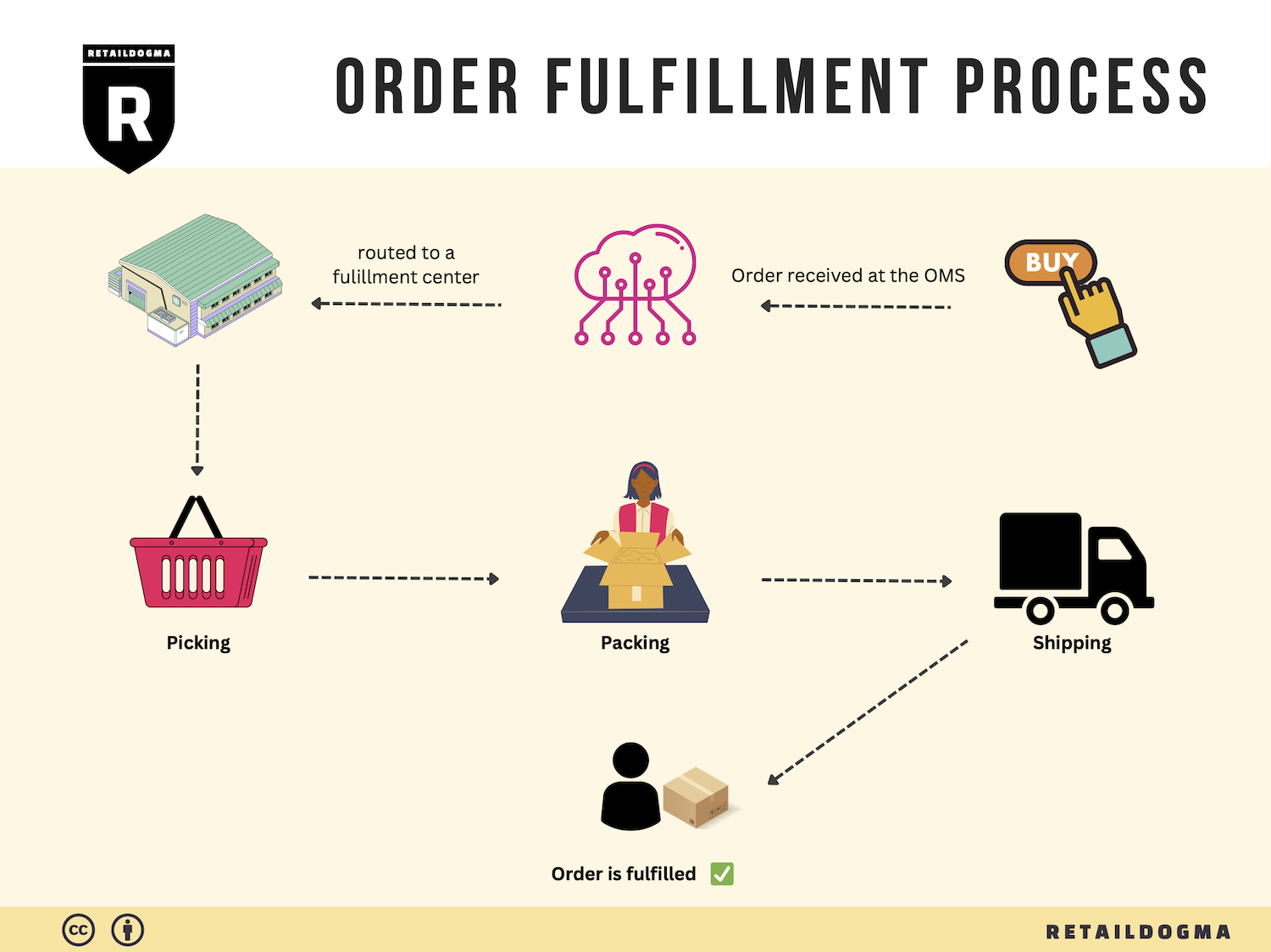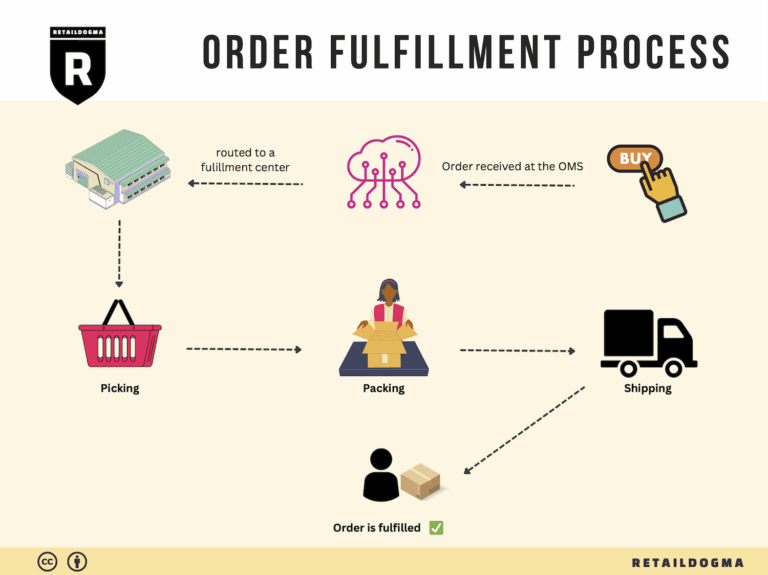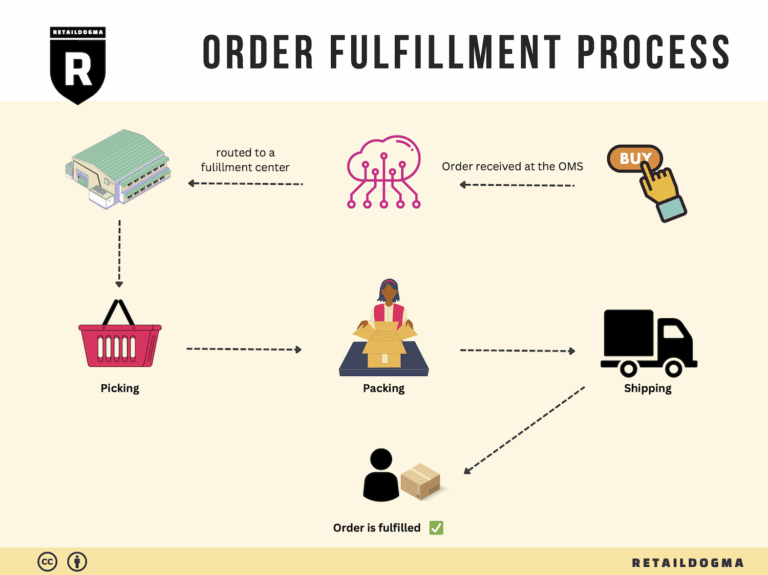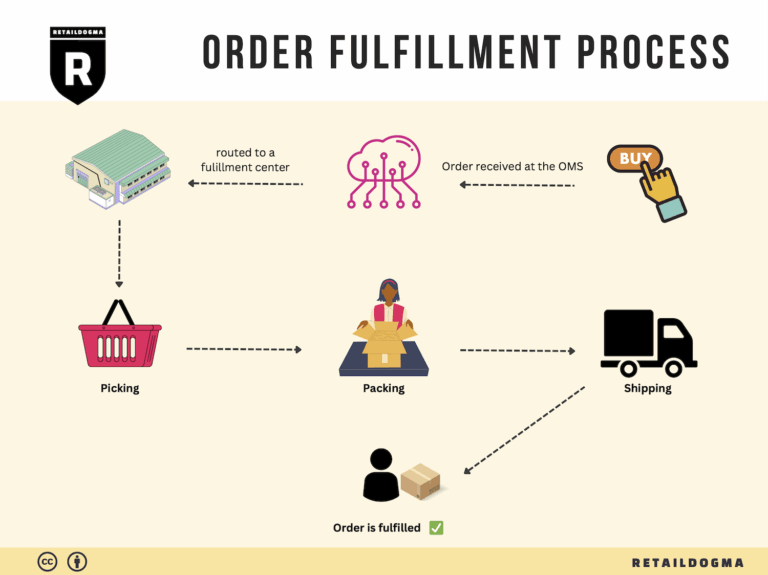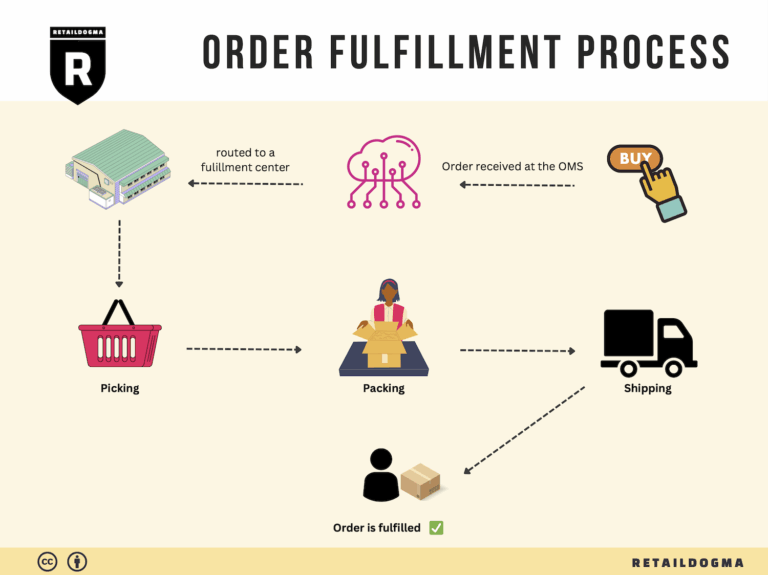What Is A Fulfillment Center? A Complete Guide (2025)
What is E-commerce Fulfillment? An Introduction for Growing Businesses
Understanding E-commerce Fulfillment
As an e-commerce business owner, you may find yourself drowning in the complexities of packing and shipping orders. The excitement of growing sales can quickly turn into a logistical nightmare, leaving you overwhelmed and struggling to keep up with demand. This is where e-commerce fulfillment comes into play. Simply put, fulfillment is the process of getting a product from your warehouse to your customer’s doorstep. It encompasses everything from inventory management and order processing to shipping and returns.
In this guide, we will explore various fulfillment models that can help streamline your operations. You might be considering using a Third-Party Logistics (3PL) provider or opting for Fulfillment by Amazon (FBA). Each of these models has its advantages, and understanding them is crucial for scaling your business effectively.
The Core Services of Fulfillment
Fulfillment services typically include several core components: inventory storage, order processing, packing, shipping, and returns management. By utilizing these services, you can free up your time to focus on growing your business, rather than being bogged down by the day-to-day logistics. Whether you decide to handle fulfillment in-house or outsource to a specialized provider, knowing what services you need is key.
Choosing the Right Fulfillment Partner
Selecting the right fulfillment partner can make or break your e-commerce success. Factors to consider include the provider’s location, technology capabilities, scalability, and customer service. A well-located fulfillment center, such as the new Amazon Fulfillment Center in Kenosha, Wisconsin (MKE1), can significantly reduce shipping times and costs, enhancing customer satisfaction.
Understanding Pricing Models
Pricing for fulfillment services varies widely and can be structured in several ways, including per-order fees, storage fees, and shipping costs. Understanding these pricing models will help you budget effectively and avoid unexpected expenses. It’s essential to analyze your order volume and product characteristics to choose a pricing structure that aligns with your business goals.
Empowering Your Business Decisions
The ultimate goal of this guide is to empower you with the knowledge needed to make informed decisions about your logistics strategy. By understanding the various fulfillment options available, the core services offered, how to choose the right partner, and the associated pricing models, you can optimize your operations. This will not only enhance efficiency but also improve customer satisfaction, helping you scale your e-commerce business successfully.

What You’ll Learn In This Guide
- What is E-commerce Fulfillment? An Introduction for Growing Businesses
- The Order Fulfillment Process: From ‘Buy’ Button to Customer’s Door
- Comparing Fulfillment Models: In-House vs. 3PL vs. Dropshipping
- A Deep Dive into Amazon FBA: Pros, Cons, and Who It’s For
- Core Services Offered by Fulfillment Centers
- How to Choose a Fulfillment Partner: A 6-Point Checklist
- Understanding Fulfillment Pricing: A Breakdown of Common Fees
- Frequently Asked Questions (FAQs) about Fulfillment
- Conclusion: Is Outsourcing Fulfillment the Right Move for Your Business?
- Important Disclaimer
The Order Fulfillment Process: From ‘Buy’ Button to Customer’s Door
1. Receiving Inventory
The order fulfillment process begins with receiving inventory at the fulfillment center. This step involves the systematic intake of products that sellers ship to Amazon’s warehouse, such as the MKE1 location in Kenosha, Wisconsin. When shipments arrive, each item is checked against the purchase order to ensure accuracy in terms of quantity and quality.
This step is crucial because it establishes a reliable inventory base for fulfilling customer orders. Errors at this stage can lead to stock discrepancies, ultimately affecting customer satisfaction and sales. A key term associated with receiving inventory is SKU (Stock Keeping Unit), which helps in tracking each product uniquely. Accurate SKU management ensures that products are correctly identified, making subsequent steps smoother.
2. Warehouse Storage
Once inventory is received and verified, it is stored in designated locations within the fulfillment center. This involves placing products in strategic areas based on their size, demand, and category. The MKE1 fulfillment center, with its vast 1.1 million square feet of space, utilizes a well-organized layout to optimize storage efficiency.
Effective warehouse storage is vital for minimizing retrieval times during order picking. Proper organization can significantly reduce operational costs and improve overall productivity. A key term here is location codes, which are used to pinpoint where each item is stored within the warehouse. This coding system allows for quick access and retrieval, essential for maintaining a fast-paced fulfillment environment.
3. Order Picking
The next step is order picking, where items are gathered based on customer orders. When a customer clicks the ‘buy’ button, a pick list is generated, detailing which products need to be collected from the warehouse. Workers then use this list to navigate through the storage areas and retrieve the items.
Order picking is a critical phase in the fulfillment process, as it directly impacts the speed and accuracy of order fulfillment. Errors in picking can lead to customer dissatisfaction and increased return rates. A key term associated with this step is pick lists, which are essential for organizing the picking process and ensuring all items are collected correctly. Advanced fulfillment centers may employ technology, such as handheld devices or automated systems, to streamline this process further.
4. Order Packing
After items have been picked, they move to the packing station. Here, products are carefully packaged for shipment. This step involves checking the items against the order details to ensure that the right products are being sent out. Appropriate packing materials are selected to protect the items during transit.
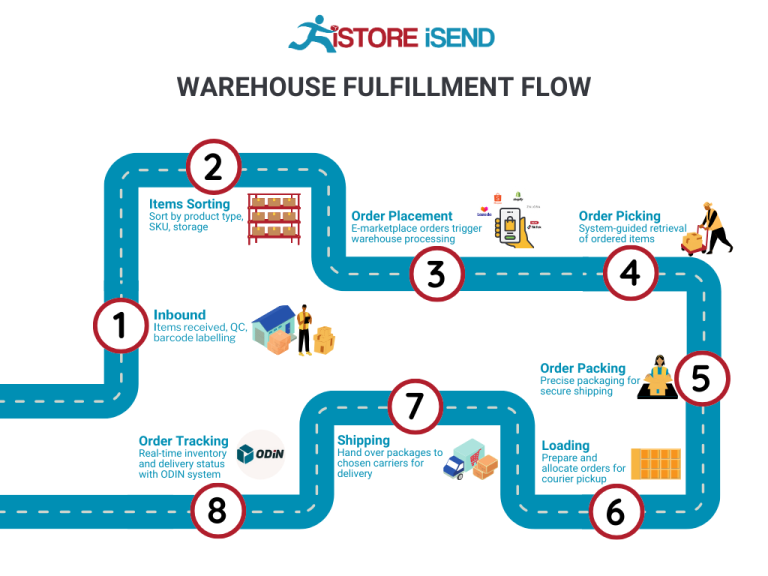
Packing is vital for maintaining product integrity and ensuring that items reach customers in excellent condition. Additionally, effective packing can help reduce shipping costs and prevent damage claims. A key term here is packaging standards, which dictate how items should be packaged based on their nature and fragility. Adhering to these standards not only enhances customer experience but also ensures compliance with shipping regulations.
5. Shipping & Delivery
The final step in the order fulfillment process is shipping and delivery. Once orders are packed, they are labeled and queued for dispatch. The fulfillment center coordinates with shipping carriers to determine the best options for delivery based on speed, cost, and destination.
Shipping and delivery are crucial because they represent the last touchpoint between the business and the customer. Timely and accurate delivery can significantly influence customer satisfaction and repeat business. A key term associated with this step is tracking numbers, which provide customers with real-time updates on their order status and location during transit. This transparency builds trust and enhances the overall customer experience, making it essential for businesses looking to scale effectively.
By understanding and optimizing each of these five steps in the order fulfillment process, e-commerce business owners can improve operational efficiency, reduce costs, and enhance customer satisfaction—key factors in scaling their sales and logistics successfully.
Comparing Fulfillment Models: In-House vs. 3PL vs. Dropshipping
Fulfillment Models Comparison
| Model | Who Handles Inventory | Best For (Business Stage) | Key Advantage | Key Disadvantage |
|---|---|---|---|---|
| In-House Fulfillment | Business itself | Established businesses with stable sales | Full control over inventory and processes | High operational costs and complexity |
| Third-Party Logistics (3PL) | External logistics provider | Growing businesses looking to scale | Scalability and reduced overhead | Less control over fulfillment process |
| Dropshipping | Supplier or manufacturer | Startups and low-capital businesses | Low startup costs and inventory risk | Lower profit margins and dependency on suppliers |
In-House Fulfillment
In-house fulfillment involves managing the entire process of inventory storage, order processing, and shipping within the business itself. This model is typically best suited for established businesses with stable sales and a well-defined customer base. The primary advantage of in-house fulfillment is the complete control it provides over inventory management and the fulfillment process. Businesses can tailor their operations to meet specific customer needs, ensuring high-quality service and faster response times. However, this model comes with significant operational costs and complexity, as it requires investment in warehouse space, staffing, and technology. Moreover, as order volumes increase, managing logistics can become cumbersome, leading to potential inefficiencies and bottlenecks.
Third-Party Logistics (3PL)
Third-party logistics (3PL) providers offer a comprehensive solution for businesses looking to outsource their logistics needs. This model is particularly advantageous for growing businesses that require scalability without the burden of managing logistics internally. A 3PL partner handles inventory storage, order fulfillment, and shipping, allowing businesses to focus on core operations such as marketing and product development. The key advantage of utilizing a 3PL is the ability to scale operations quickly without the overhead costs associated with in-house fulfillment. However, the trade-off is a loss of control over the fulfillment process, which can lead to inconsistencies in service quality and customer experience. Additionally, businesses may face challenges in communication and coordination with the 3PL, especially if they are managing multiple suppliers or locations.
Dropshipping
Dropshipping is a fulfillment model where the retailer does not hold inventory but instead transfers customer orders directly to a supplier or manufacturer, who then ships the products to the customer. This model is especially appealing for startups and businesses with limited capital, as it requires minimal upfront investment in inventory. The key advantage of dropshipping is the low financial risk associated with holding inventory, allowing entrepreneurs to test new products and markets without significant commitment. However, dropshipping often comes with lower profit margins due to reliance on suppliers for fulfillment and shipping. Additionally, businesses face challenges such as inventory management, longer shipping times, and potential quality control issues, as they have little to no oversight over the supplier’s operations. This dependency on third parties can also lead to inconsistencies in customer service, affecting overall brand reputation.
Conclusion
When choosing a fulfillment model, businesses must carefully consider their current stage of growth, operational capacity, and long-term goals. Each model presents unique advantages and disadvantages, making it essential to align the fulfillment strategy with the overall business objectives. For established businesses seeking control and customization, in-house fulfillment may be ideal. Conversely, growing businesses might benefit from the flexibility and scalability of 3PL partnerships, while startups could leverage dropshipping to minimize risk and test new markets. Understanding these dynamics will empower e-commerce entrepreneurs to make informed decisions that support their scaling efforts effectively.
A Deep Dive into Amazon FBA: Pros, Cons, and Who It’s For
Understanding Fulfillment by Amazon (FBA)
Fulfillment by Amazon (FBA) is a service provided by Amazon that allows sellers to store their products in Amazon’s fulfillment centers. Amazon then takes care of storage, packaging, shipping, and customer service for these products. This service is particularly appealing to e-commerce business owners looking to scale their operations without the headaches of managing logistics themselves.
When a customer orders a product that is fulfilled by Amazon, the company picks, packs, and ships the product directly to the customer. Additionally, Amazon handles returns and customer inquiries, allowing sellers to focus on other aspects of their business, such as marketing and product development.
How FBA Works
-
Setup: Sellers create an Amazon seller account and enroll in the FBA program. They then list their products and prepare them for shipment to an Amazon fulfillment center.
-
Inventory Management: Sellers send their inventory to one or more of Amazon’s fulfillment centers, where the products are stored until sold. The seller is responsible for ensuring that the inventory meets Amazon’s guidelines and standards.
-
Order Fulfillment: When a customer places an order, Amazon’s systems automatically process the order, picking the product from the warehouse, packing it, and shipping it to the customer.
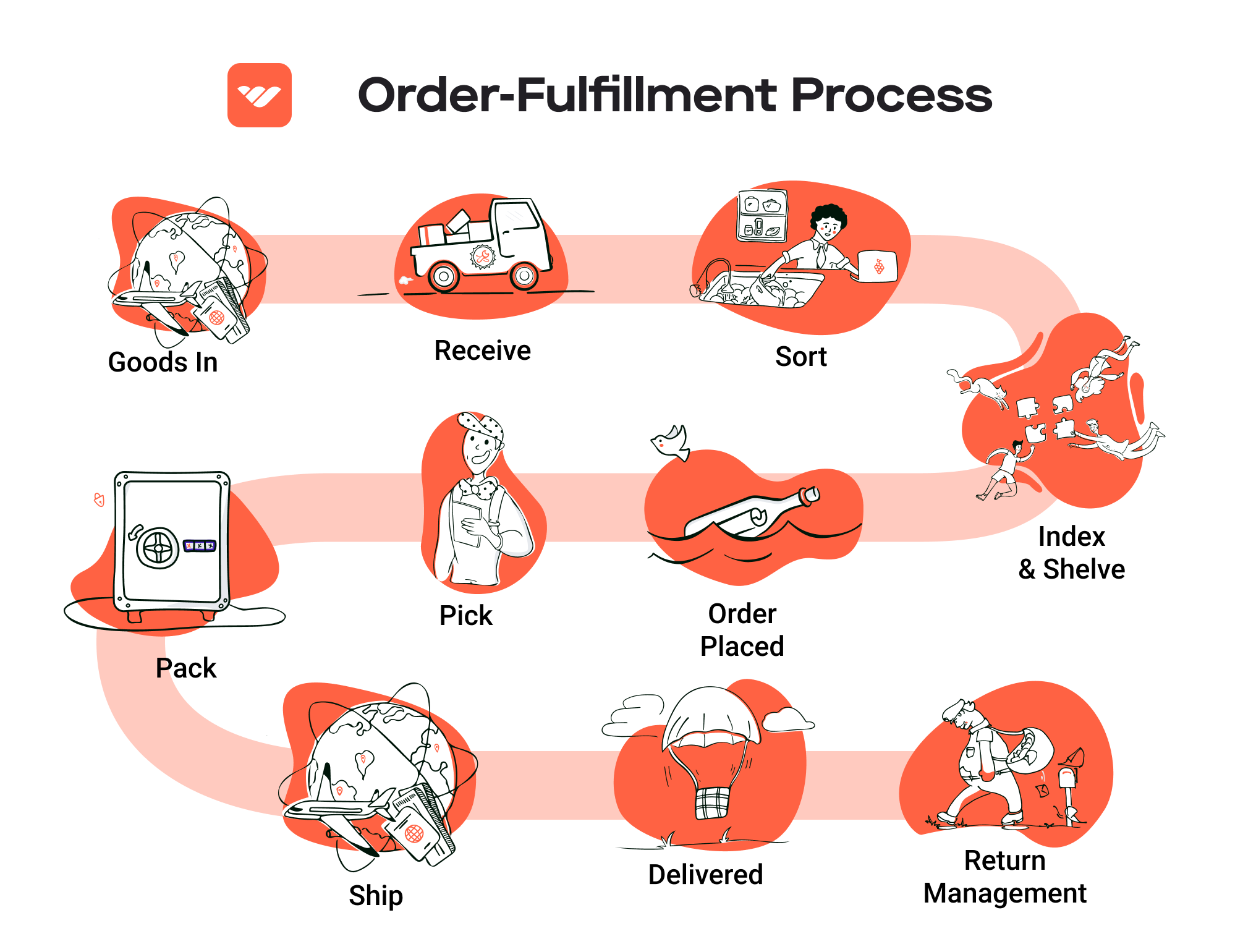
-
Customer Service: Amazon takes care of customer service inquiries and handles returns, which streamlines the process for sellers.
-
Payment: Sellers receive payments for their sales after Amazon deducts fees for the FBA service, which includes storage fees and fulfillment fees.
Pros of Using FBA
-
Prime Eligibility: Products fulfilled by Amazon are eligible for Amazon Prime, which can significantly increase visibility and sales. Prime members often prefer products with fast, free shipping, making FBA an attractive option for sellers.
-
Customer Trust: Leveraging Amazon’s established reputation can enhance customer trust. Buyers are more likely to purchase from sellers using FBA because they associate the service with reliability and quality.
-
Multi-Channel Fulfillment: FBA is not limited to Amazon.com. Sellers can use FBA to fulfill orders from their own websites or other sales channels, streamlining operations and inventory management.
-
Simplified Logistics: By outsourcing logistics to Amazon, sellers can save time and resources. This allows them to focus on growing their business rather than managing inventory and shipping.
-
Scalability: FBA can easily accommodate business growth. As sales increase, sellers can scale their inventory without needing to invest in warehouse space or logistics.
Cons of Using FBA
-
High Fees: FBA comes with various fees, including storage fees for keeping products in Amazon’s warehouses and fulfillment fees for each order processed. These costs can add up, impacting profit margins, especially for low-priced items.
-
Strict Inventory Rules: Amazon has stringent requirements regarding inventory management, packaging, and labeling. Sellers must comply with these rules to avoid penalties, which can be time-consuming and challenging.
-
Commingling Risks: FBA uses a commingling system where products from different sellers may be stored together. This can lead to issues if a customer receives a damaged or defective product that is not the seller’s fault, potentially harming their reputation.
-
Less Control Over Branding: While Amazon handles customer service and fulfillment, sellers may feel they have less control over the customer experience. This can be a concern for businesses focused on brand identity and customer engagement.
-
Inventory Management Challenges: Sellers must manage their inventory levels closely to avoid stockouts or excess inventory, which can incur additional fees. This requires careful planning and forecasting.
Who is FBA Best For?
FBA is particularly beneficial for small to medium-sized e-commerce businesses that seek to scale quickly without the burden of managing logistics. It is ideal for:
-
New Sellers: Those just starting in e-commerce can leverage Amazon’s infrastructure and customer base to gain traction quickly.
-
Brands Seeking Exposure: Businesses looking to enhance their visibility and credibility can benefit from Amazon’s reputation and Prime eligibility.
-
Sellers with High Sales Volume: Companies that experience high sales volumes can find FBA cost-effective, as the economies of scale can help offset the fees.
-
Entrepreneurs Focusing on Growth: For those wanting to focus on marketing, product development, and customer engagement, outsourcing fulfillment to Amazon can free up valuable time and resources.
-
Multi-Channel Sellers: Brands selling on multiple platforms can simplify their logistics by using FBA for all order fulfillment, ensuring a consistent and efficient process.
In conclusion, while FBA offers numerous advantages that can significantly enhance an e-commerce business’s growth potential, it also comes with challenges that sellers must carefully consider. Balancing the pros and cons will help determine if FBA is the right fit for your business model and growth strategy.
Core Services Offered by Fulfillment Centers
Inventory Management & Warehousing
Fulfillment centers provide comprehensive inventory management and warehousing services, which are critical for e-commerce businesses looking to optimize their supply chain. This service involves the systematic tracking and organization of stock levels, storage locations, and product conditions. Fulfillment centers utilize sophisticated inventory management software to monitor incoming and outgoing goods, ensuring real-time visibility of stock.
The primary benefit of effective inventory management is the reduction of carrying costs and the mitigation of stockouts or overstock situations. By maintaining optimal inventory levels, e-commerce businesses can enhance cash flow and minimize waste associated with unsold products. Furthermore, accurate inventory records enable companies to make informed purchasing decisions, ultimately leading to improved customer satisfaction through timely order fulfillment. In a competitive marketplace, the ability to manage inventory effectively can be a significant differentiator.
Pick and Pack Services
Pick and pack services are at the heart of fulfillment operations. This process involves selecting the ordered items from the warehouse shelves (picking) and then packaging them for shipment (packing). Fulfillment centers employ trained staff and automated systems to ensure that orders are processed quickly and accurately, significantly reducing the likelihood of errors.
The benefits of efficient pick and pack services are manifold. First, they contribute to faster shipping times, which is essential for meeting customer expectations in today’s fast-paced e-commerce environment. Second, accuracy in order fulfillment reduces the costs associated with returns and exchanges, thereby enhancing customer loyalty. Moreover, fulfillment centers often implement batch picking techniques, where multiple orders are processed simultaneously, further optimizing efficiency. By leveraging expert pick and pack services, e-commerce businesses can scale operations while maintaining high service levels.
Kitting and Assembly
Kitting and assembly services offered by fulfillment centers allow e-commerce businesses to streamline their product offerings. Kitting involves grouping together multiple products into a single package for sale, while assembly refers to the process of constructing a product from various components. This service is particularly beneficial for businesses that offer subscription boxes or bundled products, as it simplifies the assembly process and enhances the customer experience.
The primary advantage of kitting and assembly services is the ability to create customized product offerings that cater to specific customer needs. By providing unique bundles or assembled products, businesses can differentiate themselves in a crowded market and attract more customers. Additionally, this service can lead to cost savings in shipping and packaging, as combined products may reduce the overall weight and dimensions of shipments. Fulfillment centers equipped for kitting and assembly help businesses innovate their product lines without the need for significant capital investment in equipment or labor.
Returns Management (Reverse Logistics)
Returns management, also known as reverse logistics, is an essential service provided by fulfillment centers that involves handling returned products from customers. This process includes receiving returned items, inspecting their condition, restocking, or disposing of them as necessary. A well-organized returns management system is vital for maintaining customer satisfaction and loyalty, as easy and hassle-free returns can significantly influence buying decisions.
The benefits of efficient returns management are twofold. First, it enhances customer satisfaction by providing a seamless return experience, which is increasingly important in the e-commerce sector. Customers are more likely to purchase from a retailer that offers a straightforward returns process, knowing they can return items without complications. Second, effective reverse logistics can help recover value from returned items through refurbishment, resale, or recycling, minimizing losses associated with returns. Fulfillment centers that specialize in returns management allow e-commerce businesses to focus on growth while ensuring that customer service remains a priority.
In conclusion, the core services offered by fulfillment centers—inventory management, pick and pack, kitting and assembly, and returns management—are integral for e-commerce businesses aiming to scale operations. By leveraging these services, businesses can enhance efficiency, improve customer satisfaction, and ultimately drive growth in a competitive marketplace.
How to Choose a Fulfillment Partner: A 6-Point Checklist
Location & Warehouse Network
The geographical location of your fulfillment partner is crucial for ensuring timely delivery and minimizing shipping costs. A strategically placed warehouse network can significantly impact your logistics efficiency.
Why It Matters:
– Shipping Times: Proximity to your customer base can decrease transit times, enhancing customer satisfaction.
– Costs: Longer distances can lead to higher shipping fees, which can eat into your profit margins.
Questions to Ask:
1. What is the location of your warehouses, and how do they align with my target market?
2. Do you have multiple warehouse locations to optimize shipping routes?
3. How do you handle shipping for regions that may require additional logistics considerations, such as rural areas?
Technology & Integrations
In today’s digital age, having a robust technological backbone is essential for seamless operations. Your fulfillment partner should offer modern technology that integrates smoothly with your e-commerce platforms.
Why It Matters:
– Efficiency: Automation in inventory management, order processing, and tracking can reduce errors and save time.
– Real-Time Data: Access to real-time analytics helps in making informed business decisions.
Questions to Ask:
1. What software and technologies do you use for order fulfillment and inventory management?
2. Can your system integrate with my existing e-commerce platforms (like Shopify, Amazon, etc.)?
3. What level of reporting and analytics do you provide?
Specializations (e.g., Cold Storage, Oversized Items)
Not all fulfillment centers are equipped to handle every type of product. Understanding your specific needs will help in selecting a partner with the right capabilities.
Why It Matters:
– Product Safety: Certain items may require special handling (e.g., perishables, electronics).
– Cost Efficiency: Choosing a partner with the right specialization can reduce handling costs and improve service quality.
Questions to Ask:
1. Do you have facilities for specialized storage needs such as cold storage or oversized items?
2. What experience do you have in handling my specific product types?
3. How do you ensure compliance with safety and regulatory standards for specialized items?
Scalability & Capacity
As your business grows, your fulfillment needs will evolve. Your partner should be able to scale operations to accommodate increased demand without compromising service quality.
Why It Matters:
– Flexibility: A partner that can grow with you will save you the hassle of switching providers as your needs change.
– Resource Allocation: Ensuring capacity during peak seasons (like holidays) is essential for maintaining customer satisfaction.
Questions to Ask:
1. How do you handle fluctuations in order volume, especially during peak seasons?
2. What is your maximum capacity for order fulfillment?
3. Are there additional resources or services you can offer as I scale?
Pricing and Contracts
Understanding the financial implications of partnering with a fulfillment provider is vital for maintaining profitability. Transparency in pricing structures and contract terms can help avoid unexpected costs.
Why It Matters:
– Budgeting: Clear pricing helps in effective financial planning and resource allocation.
– Long-Term Viability: Understanding contract terms can help avoid potential pitfalls and ensure a smooth partnership.
Questions to Ask:
1. What are your pricing models (e.g., per order, storage fees, shipping costs)?
2. Are there any hidden fees I should be aware of (e.g., handling, returns)?
3. What are the terms for contract renewal or termination?
Customer Support & Reviews
The level of customer support provided by your fulfillment partner can greatly affect your operational efficiency. A responsive and reliable support team can address issues quickly, minimizing disruptions to your business.
Why It Matters:
– Problem Resolution: Quick and effective communication can prevent minor issues from escalating.
– Reputation: Partnering with a provider that has a good reputation can enhance your brand’s credibility.
Questions to Ask:
1. What customer support channels do you offer (e.g., phone, email, chat)?
2. What are your response times for support inquiries?
3. Can you provide references or reviews from other clients?
Conclusion
Choosing the right fulfillment partner is a critical step in scaling your e-commerce business. By considering these six key areas—location and warehouse network, technology and integrations, specializations, scalability, pricing, and customer support—you can ensure that you select a partner that aligns with your business goals. Taking the time to ask the right questions will help you make an informed decision that supports your growth and enhances your operational efficiency.
Understanding Fulfillment Pricing: A Breakdown of Common Fees
Initial Setup Fees
When starting with an Amazon Fulfillment Center like MKE1, businesses often encounter initial setup fees. These fees can include account creation, onboarding, and inventory setup costs. Typically, they vary based on the complexity of the integration with your existing systems. For instance, if your business requires custom configurations or specialized services, the fees may be higher. It’s essential to ask for a detailed breakdown of what the setup fee includes, as some providers may bundle services that could lead to unexpected costs.
Receiving Fees
Receiving fees are charged when your inventory arrives at the fulfillment center. This fee is calculated based on the number of units received and the complexity of the receiving process. For example, if your products need additional handling or quality checks, the receiving fee may increase. Businesses should ensure that they understand how these fees are structured, as they can vary significantly depending on the type of product being received. Consider negotiating terms or exploring alternatives if your receiving needs are more straightforward.
Storage Fees (per pallet/bin)
Storage fees are charged for the space your inventory occupies in the fulfillment center. These fees are typically assessed on a per-pallet or per-bin basis, depending on how your products are stored. The calculation is often based on the volume or weight of your products, with additional fees for long-term storage if your products remain in the facility beyond a specified period (usually six months). To manage these costs effectively, it’s wise to regularly audit your inventory levels and identify slow-moving items that may incur additional fees. Implementing inventory management strategies can help reduce storage costs.
Pick & Pack Fees (per item/order)
Pick & pack fees are incurred when an order is processed and shipped to a customer. This fee covers the costs associated with selecting the items from storage (picking) and packaging them for shipment (packing). Typically, the fee is charged per item, but it can also be structured per order, depending on the fulfillment provider. Factors that can influence these fees include the complexity of the packing process (e.g., custom packaging) and the number of items in an order. To minimize these costs, consider optimizing your product assortment and order quantities to streamline the picking process.
Shipping Fees
Shipping fees are one of the most variable costs in fulfillment pricing, depending on factors such as the shipping method, destination, package weight, and dimensions. Amazon often offers competitive rates due to its volume, but sellers should be aware of how these fees are calculated. Shipping fees may also include surcharges for expedited shipping or special handling. To control shipping costs, it’s beneficial to assess your shipping strategy regularly. Utilizing Amazon’s shipping options or negotiating rates with carriers can lead to significant savings.
Tips for Getting an Accurate Quote
-
Detail Your Needs: When requesting a quote, provide comprehensive information about your business model, product types, expected order volumes, and specific fulfillment requirements. This helps providers give you a more accurate estimate.
-
Request Itemized Quotes: An itemized breakdown of all potential fees allows you to understand exactly what you are paying for and helps prevent surprises later on.
-
Negotiate Terms: Don’t hesitate to negotiate fees, especially if your expected volume is high or if you are considering a long-term partnership. Many fulfillment centers are willing to offer discounts for larger commitments.
-
Review Contracts Carefully: Ensure you fully understand the terms and conditions of the agreement, including any penalties for early termination or changes in order volume.
-
Regularly Reassess: As your business grows and changes, your fulfillment needs may also evolve. Regularly reassessing your fulfillment strategy and costs will help you stay competitive and maximize efficiency.
By understanding these various fulfillment pricing models and proactively managing your costs, you can effectively scale your e-commerce business while maintaining healthy profit margins.
Frequently Asked Questions (FAQs) about Fulfillment
1. What is the MKE1 Amazon Fulfillment Center?
The MKE1 Amazon Fulfillment Center is located at 3501 120th Ave, Kenosha, WI, and is Amazon’s first fulfillment center in Wisconsin. Spanning over 1.1 million square feet, it operates on a four-story layout, enabling efficient storage and processing of a vast array of products for Amazon’s Fulfillment by Amazon (FBA) program.
2. How does the MKE1 Fulfillment Center benefit Amazon FBA sellers?
For Amazon FBA sellers, the MKE1 center allows for faster processing and shipping of products to customers in the Midwest. This can lead to reduced shipping times and improved customer satisfaction. Additionally, having inventory stored in Wisconsin may create a sales tax nexus, which means sellers need to register for a sales tax permit in Wisconsin.
3. What is the difference between a warehouse and a fulfillment center?
A warehouse primarily focuses on storing products, while a fulfillment center is designed to handle the entire order fulfillment process, including inventory management, order processing, packing, and shipping. Fulfillment centers, like MKE1, are equipped with advanced technology to streamline these processes and improve delivery speed.
4. What is a 3PL (Third-Party Logistics)?
A 3PL, or third-party logistics provider, is a company that offers outsourced logistics services to businesses. This can include warehousing, transportation, and distribution services. Many e-commerce businesses partner with 3PLs to enhance their supply chain efficiency and focus on core business activities.
5. How much do fulfillment services cost?
Fulfillment service costs can vary widely based on several factors, including the volume of orders, storage space required, and specific services utilized (such as picking, packing, and shipping). On average, businesses can expect to pay a monthly storage fee per cubic foot, along with per-order fulfillment fees. It’s crucial to assess your business’s unique needs and obtain quotes from multiple providers to find the best fit.
6. What are the operational hours of the MKE1 Fulfillment Center?
While specific operational hours can vary, Amazon fulfillment centers typically operate 24/7 to handle high volumes of orders. It is advisable for sellers to check with Amazon or their fulfillment dashboard for the most accurate information regarding operational hours and shipping schedules.
7. How do I send my products to the MKE1 Fulfillment Center?
To send products to MKE1, you must create a shipment plan through your Amazon Seller Central account. This involves specifying the products you intend to send, the quantity, and packaging details. Once your shipment plan is approved, Amazon will provide you with shipping labels and instructions on how to prepare and send your products.
8. What should I do if my inventory is lost or damaged at MKE1?
If your inventory is lost or damaged at the MKE1 fulfillment center, you should file a claim through Amazon Seller Central. Amazon has specific procedures for reporting lost or damaged items, and it is essential to provide detailed information and documentation to support your claim.
9. Can I use the MKE1 Fulfillment Center for international shipping?
While MKE1 primarily serves domestic orders within the United States, Amazon does offer international shipping options through its global selling program. However, it’s important to check specific requirements and restrictions for international shipping and whether your products can be shipped from this fulfillment center.
10. What are the sales tax implications of using the MKE1 Fulfillment Center?
Using the MKE1 Fulfillment Center creates a sales tax nexus in Wisconsin, meaning you are required to collect and remit sales tax on sales made to customers in that state. It is essential to register for a sales tax permit in Wisconsin and familiarize yourself with the state’s sales tax regulations to ensure compliance.
Conclusion: Is Outsourcing Fulfillment the Right Move for Your Business?
Assessing the Benefits of Outsourcing Fulfillment
Outsourcing your fulfillment needs can be a game-changer for e-commerce businesses seeking to scale efficiently. The primary benefits include significant time savings, enhanced scalability, and access to specialized expertise. By partnering with a fulfillment service, you can redirect your focus from day-to-day logistics to strategic growth initiatives. This shift allows you to invest more time in product development, marketing, and customer engagement—all critical components for driving sales.
Scalability is another compelling reason to consider fulfillment outsourcing. As your business grows, so does the complexity of managing inventory, shipping, and returns. A reliable fulfillment partner can seamlessly adjust to your changing needs, whether you’re experiencing seasonal spikes in demand or expanding into new markets. This adaptability not only alleviates operational pressure but also ensures that you can maintain high service levels without the need for substantial upfront investments in infrastructure.
Moreover, fulfillment services bring invaluable expertise to the table. With industry knowledge and advanced technology, these partners can optimize shipping routes, reduce costs, and enhance delivery speed. This level of efficiency not only improves customer satisfaction but also strengthens your competitive edge in the marketplace.
Choosing the Right Partner for Growth
However, the success of outsourcing fulfillment hinges on selecting the right partner. It’s essential to evaluate potential fulfillment centers based on their capabilities, technology, and customer service. A well-chosen partner can facilitate your growth trajectory and help you navigate the complexities of logistics with ease.
Call to Action
If you’re contemplating whether outsourcing fulfillment is the right move for your business, start by conducting a thorough audit of your current shipping processes. Identify bottlenecks, cost inefficiencies, and areas where your team is stretched too thin. This analysis will provide clarity on whether a fulfillment partner could enhance your operations and fuel your growth. Take the first step today—your future success may depend on it.
Important Disclaimer
⚠️ Important Disclaimer
The information in this guide is for educational purposes. Fulfillment services, pricing, and platform features change frequently. Always conduct your own due diligence and consult with providers directly before making business decisions.
